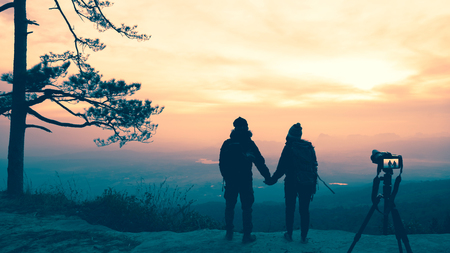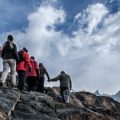1. Choosing the Right Footwear
If you’re new to hiking in the U.S., your shoes are the most important piece of gear you’ll buy. The right footwear can make a world of difference in comfort, safety, and enjoyment on the trail. Whether you’re tackling rocky mountain paths or strolling through forested state parks, what’s on your feet matters.
Why Good Hiking Footwear Matters
American trails vary from muddy East Coast woods to dusty desert canyons out West. Regular sneakers might work for short city hikes, but for real trails, you need something sturdier. Quality hiking boots or trail shoes provide:
- Grip: Prevents slipping on uneven ground.
- Ankle Support: Helps avoid sprains on rocky terrain.
- Protection: Shields your feet from sharp rocks, roots, and critters.
- Comfort: Reduces blisters and sore feet over long distances.
Types of Hiking Footwear
| Type | Best For | Main Features |
|---|---|---|
| Trail Runners | Easy to moderate trails, speed hiking | Lightweight, breathable, less ankle support |
| Hiking Shoes | Mild to moderate terrain, day hikes | Cushioned, flexible, low-cut design |
| Hiking Boots | Rugged trails, backpacking trips | Durable, ankle support, waterproof options |
Tips for Finding the Perfect Fit in the U.S.
- Shop Later in the Day: Feet swell as you walk; trying shoes on when they’re at their largest helps ensure a good fit.
- Wear Your Hiking Socks: Bring the socks you’ll hike in to get a true feel for fit.
- Test Them Out: Walk around the store and try inclines if available; your toes shouldn’t hit the front of the shoe going downhill.
- Break Them In: Wear them around town before hitting the trail to avoid blisters.
- Avoid “Too Snug”: You want secure heels but enough toe room—think “finger width” between your longest toe and the end of the shoe.
Popular American Brands to Consider
- Keen
- Merrell
- SALOMON
- The North Face
- Danner (great for classic American style)
Selecting sturdy hiking boots or trail shoes is the first step toward an enjoyable adventure on America’s diverse trails. The right pair will keep you comfortable and safe wherever your journey takes you.
2. Layering Clothing for Changing Weather
When youre new to hiking in the U.S., one of the most important things to learn is how quickly the weather can change—sometimes within a single hour! Thats why understanding how to layer your clothing is key. The right layers help you stay comfortable, dry, and safe, whether you’re trekking through the Pacific Northwest, hiking the Rockies, or exploring the Appalachian Trail.
Why Layering Matters
Layering lets you adjust your clothing as temperatures shift or rain clouds roll in. Instead of relying on one heavy jacket or bulky sweater, you combine different types of clothes that each serve a special purpose. This approach keeps you warm when its chilly, cool when youre active, and dry if it rains.
The Three-Layer System
| Layer | Main Purpose | Typical Materials | U.S.-Friendly Examples |
|---|---|---|---|
| Base Layer | Wicks sweat away from skin | Polyester, merino wool, nylon (avoid cotton) | Moisture-wicking t-shirt or long-sleeve top from brands like Patagonia or REI Co-op |
| Insulating Layer | Keeps you warm by trapping body heat | Fleece, down, synthetic fill | Lightweight fleece pullover or puffy jacket (like The North Face Thermoball) |
| Outer Layer (Shell) | Protects against wind and rain | Nylon with waterproof/breathable membrane (like Gore-Tex) | Rain jacket such as Columbia Watertight II or Marmot PreCip Eco |
Tips for Smart Layering on American Trails
- Avoid Cotton: Cotton holds moisture and can make you cold. Stick to synthetic or wool fabrics.
- Packing Extras: Always bring an extra layer in your backpack—weather can change fast in places like Colorado or the Adirondacks.
- Pace Yourself: If you start feeling too hot, take off a layer before you get sweaty; if you stop for a break and feel chilled, add a layer right away.
- Pocket Essentials: Look for jackets with zippered pockets so you can easily stash snacks, your phone, or a trail map.
- Fit Matters: Layers should fit comfortably over each other without being too tight.
Pro Tip: Local Outfitters Can Help!
If you’re not sure what works best for your local trails or climate, visit a nearby outdoor store like REI or Backcountry—they’ll help you find gear that fits both your needs and your budget.

3. Backpacks and Gear Organization
Choosing the right backpack is a game-changer for beginner hikers. You don’t need anything fancy—a simple, lightweight daypack with padded shoulder straps and a breathable back panel will do the trick. Look for packs in the 15-30 liter range, which is just the right size for a day hike in most U.S. parks or trails.
How to Choose a Daypack
| Feature | Why It Matters | What to Look For |
|---|---|---|
| Size/Capacity | Keeps you from overpacking or underpacking | 15-30 liters for day hikes |
| Fit & Comfort | Prevents sore shoulders and back pain | Padded straps, adjustable chest/waist belts |
| Ventilation | Makes hiking cooler and more comfortable | Mesh back panels or airflow channels |
| Pockets & Compartments | Makes organizing gear easy and accessible | Multiple pockets, water bottle sleeves, internal dividers |
Smart Gear Organization Tips
Packing your essentials efficiently helps you stay prepared without feeling overloaded. Here’s a quick rundown of what to bring and how to organize it:
| Item | Packing Tip | Purpose |
|---|---|---|
| Water Bottle or Hydration Bladder | Store in side pocket or hydration sleeve for easy access | Stay hydrated during your hike—aim for at least 2 liters on warm days. |
| Snacks (trail mix, energy bars) | Keep in outer pocket or top lid for quick grabs | Sustain energy with high-protein, high-carb foods. |
| Sunscreen & Bug Spray | Pack in a small zip bag in an outside compartment | Protect your skin from sunburn and bug bites. |
| First-Aid Kit (mini) | Tuck into an easy-to-reach inner pocket | Handle minor scrapes, blisters, and emergencies. |
| Map & Compass or GPS App on Phone | Stash in waterproof pouch or secure phone pocket | Avoid getting lost even if cell service drops out. |
| Light Jacket/Rain Shell | Roll up at the bottom or use pack’s stretch cord | Be ready for sudden weather changes. |
| Trekking Poles (if needed) | Attach to pack’s external loops | Add stability on rocky or steep terrain. |
Packing Pro Tips:
- Keep heavy items close to your back: This helps balance weight so you don’t feel off-kilter as you walk.
- Use resealable bags: Keeps snacks dry and first-aid supplies organized.
- Don’t overload: Stick with the basics—if you’re not sure you’ll use it, leave it at home.
- Tidy up after every hike: Restock snacks and first aid so you’re always ready to hit the trail again!
The right backpack and smart organization make all the difference between a fun outing and a tough slog. Invest a little time upfront, and youll be ready for whatever adventure comes your way.
4. Navigation Basics
When you’re heading out on a new trail, especially in the vast and varied landscapes of America, knowing how to navigate is essential. Even if you plan to stick to well-marked paths, things can change quickly—trail signs might be missing, or you could lose your way at a confusing junction. That’s why carrying reliable navigation tools and knowing how to use them is a must for beginner hikers.
Why Navigation Tools Matter
A map, compass, and GPS device are more than just handy gadgets—they’re your safety net in unfamiliar terrain. Even popular American trails like those in Yosemite, the Rockies, or the Appalachian Mountains can be tricky to follow at times. Cell service isn’t always available in remote areas, so don’t rely solely on your phone.
Basic Navigation Tools Comparison
| Tool | Pros | Cons |
|---|---|---|
| Map & Compass | No batteries needed; works anywhere; helps build real navigation skills | Takes practice to use; paper maps can get wet or tear |
| Handheld GPS Device | Shows exact location; easy to track route; some models have emergency features | Needs batteries; can malfunction; more expensive |
| Smartphone App | Convenient; often free or low cost; easy to download maps before your hike | Battery drains fast with GPS on; may not work if phone breaks or gets wet |
Navigating Popular American Trails
If you’re hiking well-known trails like the Pacific Crest Trail or the Grand Canyon’s South Kaibab Trail, you’ll likely find lots of markers and signs. But don’t let that lull you into complacency. Weather, construction, or natural changes can alter familiar paths. Always double-check your route before heading out and keep your navigation tools easily accessible.
Quick Tips for Beginner Hikers:
- Practice at home: Learn how to read a map and use a compass before hitting the trail.
- Download offline maps: If using your smartphone, make sure you have maps saved for offline use.
- Mark waypoints: Note important spots like trailheads, water sources, and campsites on your map or app.
- Check local info: Some U.S. parks post updates about closed trails or detours online—always review these before your hike.
With the right navigation basics, you’ll feel more confident exploring all kinds of American trails and ensure you stay safe while enjoying the great outdoors.
5. Essential Safety and Comfort Items
When youre starting out with hiking in the United States, its important to pack smart—not just for fun, but for your safety and comfort too. Even on short trails, being prepared can make all the difference. Here are the must-have items every beginner should bring along.
Hydration: Water Bottles and Hydration Systems
Staying hydrated is a top priority. Most American hikers carry a reusable water bottle or hydration bladder (like a CamelBak). The general rule is to drink about half a liter of water per hour of moderate activity in moderate temperatures.
| Hydration Gear | Benefits |
|---|---|
| Reusable Water Bottle | Eco-friendly, durable, easy to refill on trail |
| Hydration Bladder | Hands-free drinking, fits inside backpack, holds more water |
Snacks for Energy
You’ll want to keep your energy up as you hike. Pack easy-to-carry snacks that don’t spoil quickly. Classic American options include trail mix, granola bars, jerky, and peanut butter sandwiches.
| Snack Ideas | Why They Work |
|---|---|
| Trail Mix | Packed with protein and carbs, lightweight |
| Granola Bars | Convenient, non-perishable, quick energy boost |
| Jerky | High in protein, long shelf life |
| Dried Fruit | Satisfies sweet tooth, adds quick sugars |
Personal Identification and Emergency Info
No matter where you hike in the U.S., always bring some form of personal identification—like your driver’s license or a state ID card. It’s also wise to carry a card with emergency contact numbers and any important medical info. Many hikers tuck this into a small waterproof bag inside their backpacks.
Basic First-Aid Kit: Be Ready for Minor Injuries
A basic first-aid kit doesn’t need to be fancy or expensive, but it should cover minor scrapes, blisters, or insect bites. Here’s what most American hikers include:
- Bandaids of various sizes
- Moleskin for blisters
- A few antiseptic wipes
- Pain relievers (like ibuprofen)
- A pair of tweezers (for splinters or ticks)
- A small roll of medical tape or gauze pads
Packing Tip:
You can find ready-made first-aid kits at outdoor stores like REI or Walmart. These are usually compact and perfect for day hikes.


